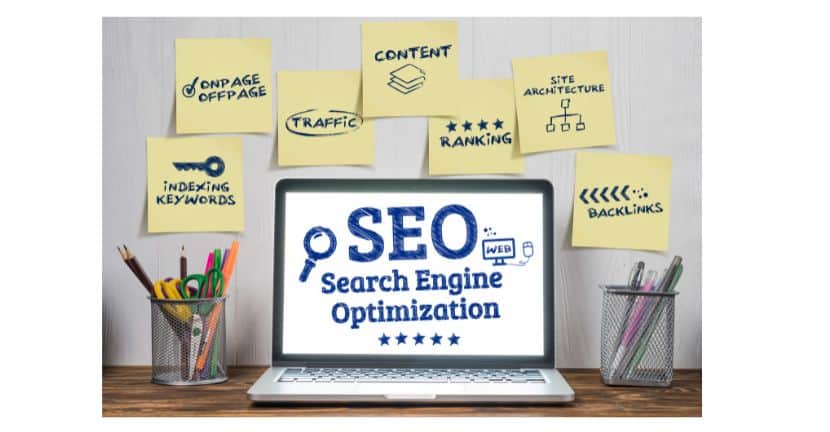SEO (Search Engine Optimization) techniques are essential for improving rankings because they help search engines understand your content, interpret its relevance to user queries, and determine the overall quality and authority of your website.

4 Key SEO Techniques
1. Keyword Research
Conduct keyword research using tools like Google Keyword Planner or SEMrush to find relevant keywords. Remember that combining keyword research with a deep understanding of your target audience is key to selecting the most effective keywords for your website.
Let’s take a look at how you can use Google Keyword Planner to conduct keyword research.
Access Google Keyword Planner:
- Log in to your Google Ads account (or create one if you don’t have one yet).
- Once logged in, go to the “Tools & Settings” menu and select “Keyword Planner” under the “Planning” section.
Start a New Plan:
- Click on “Discover new keywords” to start a new keyword research plan.
Enter Keywords or Website:
- Enter either relevant keywords related to your business or website or input your website’s URL.
- If you enter keywords, Google Keyword Planner will provide suggestions based on those terms. If you use a website, it will generate keyword ideas related to your site’s content.
Filter and Customize:
- Adjust the targeting settings, including location, language, and search network, to refine your results based on your target audience.
- You can also set the date range for historical data if needed.
Review Keyword Ideas:
- The tool will present a list of keyword ideas along with metrics like average monthly searches, competition, and bid estimates (if you’re using Google Ads).
- Pay attention to the relevance, search volume, and competition metrics.
Filter and Sort Results:
- Utilize the filter options to refine the results based on your preferences. You may want to filter out low-search-volume keywords or focus on specific topics.
- Sort the results by relevance, search volume, competition, or other metrics to prioritize the most valuable keywords for your strategy.
Explore Historical Metrics:
- Check historical metrics to understand the trends of a particular keyword over time. This can help you identify seasonality and make informed decisions.
Add Keywords to Your Plan:
- Once you’ve identified promising keywords, add them to your plan. You can then review the forecasted performance for these keywords, including estimated clicks, impressions, and costs.
Download or Export Data:
- If needed, download the keyword list or export it for future reference or integration into other tools.
Refine and Iterate:
- Keyword research is an ongoing process. Regularly revisit your keyword strategy, especially when there are changes in your industry or target audience behavior. Stay flexible and adapt your strategy based on new insights.
2. On- Page Optimization
On-page optimization is crucial for improving website rankings because it helps search engines understand the content on your pages and determines how relevant and valuable they are to users.
1. Keyword Research
For on- page optimization the first could be conducting a thorough keyword research. On the basis of your research findings you can create high-quality, relevant content that addresses the needs and interests of your target audience. To achieve best results from any content that you produce, make sure that it is of real value to the users.
2. Title Tags
Next, you can optimize your title tags. Craft a compelling and descriptive title tag that includes your target keyword. Keep it within the character limit to ensure it displays properly in search results.
3. Meta Descriptions
Similarly, you can work on your meta description as well. Write a concise and engaging meta description that summarizes the content and encourages clicks. Include relevant keywords and stick to the character limit for maximum visibility.
4. Header Tags
Use header tags to structure your content hierarchically. Include your main keyword in the H1 tag and use H2-H6 tags for subheadings. You can use tools like Yoast SEO to ensure that the keywords are used wherever possible.
5. URLs
Create clean and descriptive URLs that include your target keywords. Avoid using generic URLs with numbers and symbols.
6. Image Optimization
Optimize images by using descriptive filenames and adding alt text. Compress images to improve page loading times without sacrificing quality. Using alt text for your images is important as it helps in improving your website accessibility.
7. Internal And External Linking
Use internal links to connect relevant pages within your website. This helps distribute link equity and guides users to related content. Include outbound links to reputable and authoritative sources. This adds credibility to your content and provides additional resources for users.
3. Mobile Optimization
As of December 2023, 92.3% of internet users access websites using their mobile devices. So, ensure that your website is mobile-friendly because Google prioritizes mobile-friendly websites in search results. You can test your site using Google’s Mobile-Friendly Test tool.
4. Improve User Experience (UX)
Improving user experience (UX) is not only beneficial for your website visitors but it also plays a crucial role in boosting website rankings. Search engines, like Google, consider user satisfaction as a ranking factor. So let’s go through some of the key strategies to enhance user experience to improve your website rankings:
1. Responsive Design:
- Ensure your website is responsive and adapts seamlessly to different devices and screen sizes. Google is known to favor mobile-friendly websites, and responsive design contributes to a positive user experience.
2. Page Loading Speed:
- Optimize page loading times by compressing images, minimizing HTTP requests, and leveraging browser caching. Use tools like Google PageSpeed Insights to identify and address speed issues.
3. Intuitive Navigation:
- Create a clear and intuitive navigation structure, making it easy for users to find the information they seek. Use descriptive menu labels and organize content logically.
- A website that is structured in a haphazard manner can frustrate the users and lead to an increase in bounce rates. So avoid this by creating easy navigation.
4. Readability and Formatting:
- Use readable fonts and maintain a proper font size for easy reading.
- Break up content with headings, subheadings, bullet points, and white space to enhance readability.
5. Clear Calls-to-Action (CTAs):
- Place clear and compelling CTAs throughout your site to guide users on what actions to take.
- Make buttons and links stand out with contrasting colors.
6. Minimize Intrusive Elements:
- Avoid intrusive pop-ups or ads that obstruct the main content, especially on mobile devices.
7. Multimedia Optimization:
- Optimize images and multimedia elements for faster loading times without sacrificing quality.
- Provide alternative text for images to assist users with disabilities and improve SEO.
8. Interactive Elements:
- Include interactive elements, such as buttons, forms, or quizzes, to engage users and enhance the overall experience.
9. Search Functionality:
- Implement a functional search feature to help users quickly find specific information. Display relevant search results with clear navigation options.
10. Consistent Branding:
- Maintain consistent branding, including logos, colors, and messaging, to reinforce your brand identity across all pages. By doing this, you are creating a continuity throughout all your web pages.
11. Secure and Trustworthy:
- Ensure your website has an SSL certificate to provide a secure browsing experience.
- Display trust signals, such as security badges and customer testimonials, to build trust with users.
13. Accessibility:
- Design your website to be accessible to users with disabilities, including those with visual or auditory impairments. Use semantic HTML and provide text alternatives for non-text content.
14. Feedback Mechanisms:
- Include feedback mechanisms, such as surveys or contact forms, to gather insights from users. Use this feedback to make continuous improvements to your website.
15. Social Proof:
- Showcase positive reviews, testimonials, or social media mentions to build trust with your audience. This makes it easier for the website visitors to connect with you.
16. Progressive Web App (PWA) Features:
- Implement PWA features for improved offline access, faster loading, and a more app-like experience.
17. Localized Content:
- If applicable, provide content relevant to the user’s location or language for a personalized experience.
18. Regular Testing:
- Conduct usability testing to identify and address any issues that users may encounter.
- A/B testing can help optimize different elements for better performance.
19. Monitoring Analytics:
- Use analytics tools, such as Google Analytics, to monitor user behavior and identify areas for improvement. Analyze bounce rates, time on page, and other metrics to gauge user satisfaction.
4. Conduct Regular SEO Audits
Regular SEO audits are crucial for ensuring that your website maintains optimal performance and improves its rankings over time. For doing this, you can start by reviewing your SEO strategy. Understand your business goals, target audience, and key performance indicators (KPIs). Ensure that your SEO efforts align with your broader business objectives.
Next, you can do a keyword analysis to learn if your keywords are still relevant, to look for new keywords and identify high- potential keywords. You should also audit your content to ensure that it is high-quality, relevant, and aligned with your target keywords. Identify and update outdated content, and look for opportunities to create new content based on emerging trends or user queries.
Use strategies mentioned in the “On-Page Optimization” section and update all necessary elements and make sure that they are well-optimized for your target keywords. Check for any missing or duplicate meta tags and correct them.
Similarly, you should also conduct a technical SEO Audit. In this step, you can examine your website’s technical aspects. Look for crawl errors, broken links, and issues with XML sitemaps.
Verify that your website is accessible to search engine bots and users alike. Check for proper implementation of canonical tags.
Next, assess your website’s loading speed on both desktop and mobile devices. Optimize images, leverage browser caching, and address any other factors affecting page speed.
Use tools like Google PageSpeed Insights to identify areas for improvement.
Confirm that your website is mobile-friendly. Google prioritizes mobile-friendly websites in its rankings. Evaluate and address any mobile optimization issues.
Conduct a backlink audit. You can do this by examining your backlink profile. Identify and disavow any toxic or spammy backlinks. Seek opportunities for building high-quality, relevant backlinks. Monitor anchor text diversity and ensure a natural link profile.
Analyze data from tools like Google Analytics and Google Search Console. Identify trends in organic traffic, user behavior, and keyword performance.
Set up custom reports and alerts to stay informed about significant changes.
It is also to analyze your competitor. Regularly analyze your competitors’ strategies. Identify new players in your industry and understand their SEO tactics. Learn from successful competitors and incorporate effective strategies into your own approach.
Always stay informed about major search engine algorithm updates and changes in SEO best practices. Adapt your strategies to align with the latest industry trends and search engine guidelines.
Assess the overall user experience on your website. Look for areas of improvement in navigation, readability, and overall user satisfaction. Use heatmaps and user feedback tools to gather insights.
Develop a regular reporting schedule to track the progress of your SEO efforts. Share reports with stakeholders and make data-driven decisions. Adjust your strategy based on the performance data gathered during audits.
